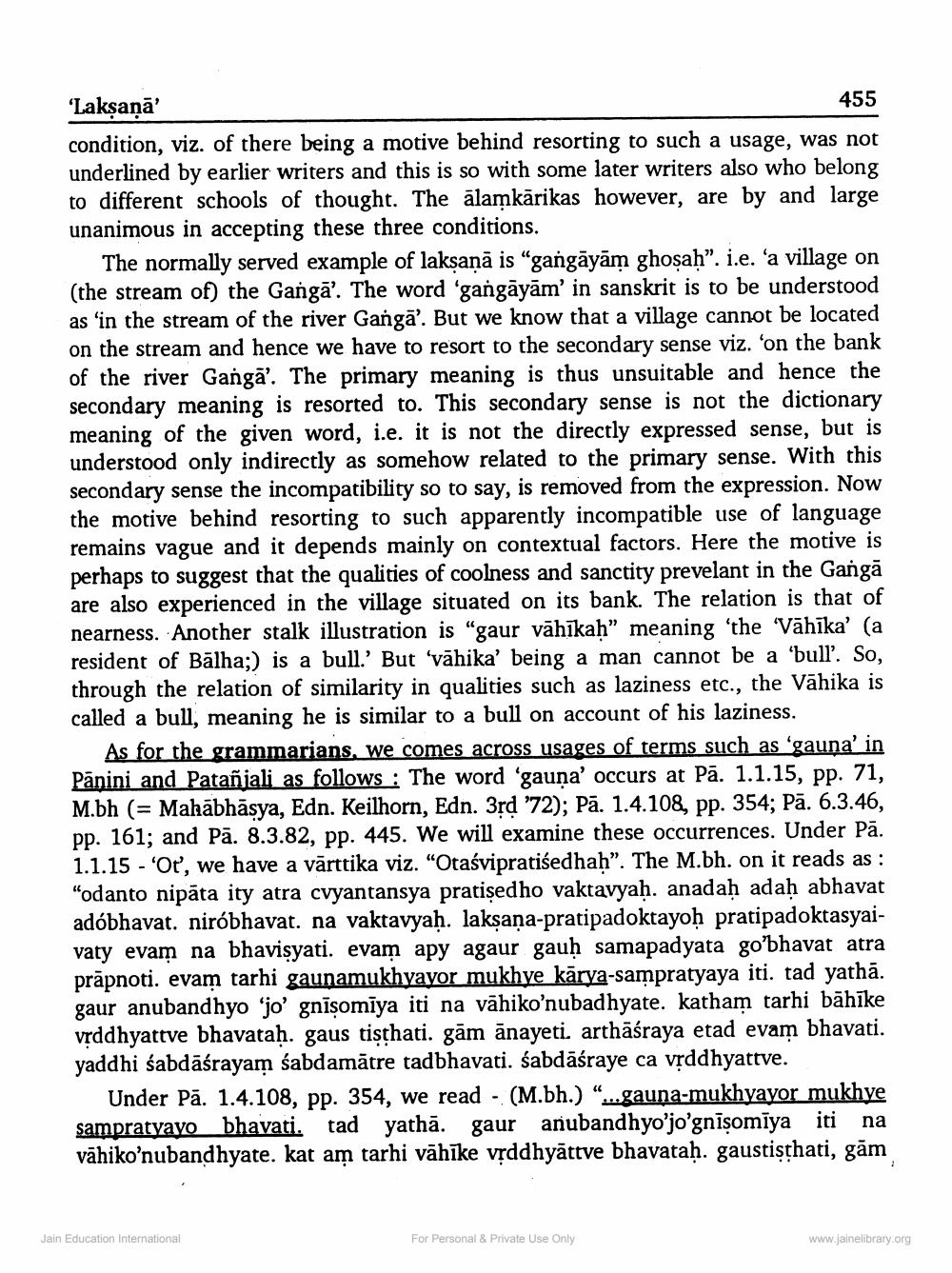________________
'Laksanā
455 condition, viz. of there being a motive behind resorting to such a usage, was not underlined by earlier writers and this is so with some later writers also who belong to different schools of thought. The alamkārikas however, are by and large unanimous in accepting these three conditions.
The normally served example of lakṣaṇā is “gangāyām ghosah”. i.e. ‘a village on (the stream of the Gangā'. The word 'gangāyām'in sanskrit is to be understood as 'in the stream of the river Gangā'. But we know that a village cannot be located on the stream and hence we have to resort to the secondary sense viz. 'on the bank of the river Ganga'. The primary meaning is thus unsuitable and hence the secondary meaning is resorted to. This secondary sense is not the dictionary meaning of the given word, i.e. it is not the directly expressed sense, but is understood only indirectly as somehow related to the primary sense. With this secondary sense the incompatibility so to say, is removed from the expression. Now the motive behind resorting to such apparently incompatible use of language remains vague and it depends mainly on contextual factors. Here the motive is perhaps to suggest that the qualities of coolness and sanctity prevelant in the Gangā are also experienced in the village situated on its bank. The relation is that of nearness. Another stalk illustration is "gaur vāhīkah” meaning 'the 'Vāhīka' (a resident of Bālha;) is a bull.' But 'vāhika' being a man cannot be a 'bull. So, through the relation of similarity in qualities such as laziness etc., the Vāhika is called a bull, meaning he is similar to a bull on account of his laziness.
As for the grammarians, we comes across usages of terms such as 'gauna' in Pānini and Patañjali as follows : The word 'gauna' occurs at Pā. 1.1.15, pp. 71, M.bh (= Mahābhāsya, Edn. Keilhorn, Edn. 3rd '72); Pā. 1.4.108, pp. 354; Pa. 6.3.46, pp. 161; and Pā. 8.3.82, pp. 445. We will examine these occurrences. Under Pā. 1.1.15 - 'Or, we have a vārttika viz. “Otaśvipratiśedhah”. The M.bh. on it reads as : "odanto nipāta ity atra cvyantansya pratişedho vaktavyah. anadah adah abhavat adóbhavat. niróbhavat. na vaktavyaḥ. laksana-pratipadoktayoḥ pratipadoktasyaivaty evam na bhavisyati. evam apy agaur gauh samapadyata go'bhavat atra prāpnoti. evam tarhi gaunamukhyayor mukhye kārya-sampratyaya iti. tad yathā. gaur anubandhyo 'jo' gnisomiya iti na vāhiko’nubadhyate. katham tarhi bāhīke výddhyattve bhavataḥ. gaus tisthati. gām ānayeti. arthāśraya etad evam bhavati. yaddhi śabdāśrayam sabdamātre tadbhavati. śabdāśraye ca vrddhyattve.
Under Pā. 1.4.108, pp. 354, we read - (M.bh.) “...gauna-mukhyayor mukhye sampratyayo bhavati. tad yathā gaur anubandhyo'jo'gnisomiya iti na vāhiko'nubandhyate. kat am tarhi vāhīke vrddhyātrve bhavatah. gaustisthati, gām
Jain Education International
For Personal & Private Use Only
www.jainelibrary.org




